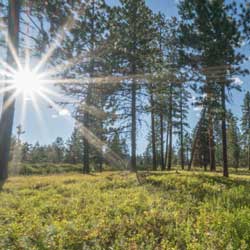The Oregon Department of Forestry leads the 20-Year Landscape Resiliency Strategy to improve forests and rangelands to reduce wildfire risk. ODF developed the plan with private, local, state, and federal partners to target about 13 million high-risk acres.
VISION: Healthy and resilient landscapes that support Oregon's social, economic, and ecological needs for future generations.

The plan uses many tools like thinning forests, prescribed burns, removing invasive species, and restoring lands after fires. The work aims to help economic development and steward lands that can endure extreme fire, drought, and pests.
The partners use a shared stewardship model – large scale, cross-boundaries, joint priorities – to align federal, state, and private investments. It requires long-term commitment to succeed. The model will sustain partner engagement and include more voices.
The plan sets criteria for priority landscapes using:
- Forest and wildland health symptoms and high wildfire risk indicators.
- Wildland-urban interface (WUI).
- Local knowledge and experts.
Using this information, ODF and the partners created the state's priority landscape map. Partners will use the map to align priority actions and investments to the places of greatest need.
ODF and its partners launched the strategy at the 2023 Inaugural Landscape Resiliency Summit. The partners shared strong support and commitment for this unified approach to:
- Reduce wildfire risk.
- Improve ecosystems.
- Protect water resources, wildlife habitat, and recreational opportunities.
- Bolster the economy.
- Increase the pace and scale of land management and stewardship.
During the summit others joined the launch, including Tribes, community groups, partnerships and collaboratives, scientists, and local groups who will be part of the ongoing work.
Next steps
Coming out of the summit, partners agreed on some next steps needed to achieve the strategy's goals. The next steps are:
-
Partnerships. The partners will broaden and strengthen relations with Tribes, local communities, the private sector, and collaborative groups to enhance cross-boundary work and clear communication.
-
Plan. The partners will use a decision-support framework to align priorities, work and investments.
-
Execute. Once aligned they ensure work happens in the right place, at the right scale, with the right tools.
-
Dashboard. Partners will create a unified tracking system and dashboard to show investments, actions, and results.
Leading the way
ODF has and continues serving forestry needs across the state. ODF grounds its success in a staff of forestry professionals, wildlife biologists, water quality experts, and natural resource specialists. This team will speed up the work using this unified strategy.
ODF has three main state-funded programs that contribute to the strategy.
Since 2021, the state has invested over $40 million through these programs. To multiply the state investment the agency manages similar federally funded programs.
In 2024 the three main programs directed $13.1 million of Oregon's general fund and $1.4 million of federal funds to speed up work on over 100,000 acres. An example of gaining alignment is through the agency's FFR program. According to the
Council of Western State Foresters 2023 Report, FFR leads the nation in managing federal forests using the Good Neighbor Authority. This authority allows the state to work on federal lands, making the work happen more quickly.
Recently, ODF captured tens of millions of Bi-partisan Infrastructure Law and Inflation Reduction Act (BIL/IRA) and other funds. These funds help urban forestry, forest health, community wildfire defense, and reducing wildfire risk. Federal agencies received most BIL/IRA funds to align investments with state projects to reduce wildfire risk, a great benefit to Oregon. The work will need to happen over decades. As ODF puts the strategy into practice, it will make every dollar and every acre count.